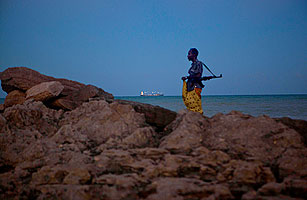
Guarding the Loot A pirate in the Somalian town of Hobyo stands against the backdrop of a hijacked Greek freighter
(3 of 4)
In early February, the pirates returned to Haradheere. Amid celebratory drinking, dancing, gunfire and chewing of khat (a stimulant), one pirate took pity on the Kenyan crew. Amere says the pirate gave him a satellite phone and enough fuel for a day, and at 4 a.m. the Golden Wave slipped out of Haradheere. Once at sea, the crew picked up an escort from a Finnish warship, and they finally returned home to Mombasa on Feb. 17, six months after they set out.
Surface Tension
The pirates' ability to act seemingly with impunity illustrates an uncomfortable realization now dawning on the navies of the world: that even in the 21st century, when warships can fire cruise missiles through a window in downtown Tripoli, controlling piracy is beyond them. Peter Hinchliffe, secretary general of the International Chamber of Shipping and the International Shipping Federation, says that while the warships created a small secure corridor through the Gulf of Aden, "no one asked, If we do this, what will the pirates do? And, of course, they simply moved elsewhere."
Even if the world's navies agree on a plan — Hinchliffe suggests targeting mother ships — it's not certain that military muscle alone can end piracy. When the international armada began arresting pirates, Kenya initially volunteered to imprison them, then balked when it realized how many there would be: 1,007 by May 2011, according to the U.N. Office for Drugs and Crime (UNODC). In an attempt to meet the size of the problem, the UNODC has rehabilitated a jail in Hargeysa, Somalia, that can hold 460 inmates. Small numbers of pirates are also working their way through the justice systems of 20 countries from the U.S. to Japan. But piracy is potentially limitless. While the UNODC reckons there are currently some 2,500 Somali pirates, the number of unemployed Somali men available to replace any who are detained runs to hundreds of thousands.
The biggest single obstacle to ending piracy is that it pays so well. Not so long ago, a few hundred thousand dollars would free a ship. Today a tanker goes for $5 million to $10 million. Hinchliffe estimates total ransoms paid in 2010 at anywhere from $75 million to $238 million and the return for a pirate investor at around 10,000%. With no other way of freeing sailors, shipowners or their insurers continue to pay. Says Alan Cole, a Nairobi-based piracy specialist at the UNODC: "The shipowners say, 'There's no way we can get people back apart from paying ransoms.' And the governments say, 'If you keep paying ransoms, there is no way we're going to be able to stop this.'"
One recent development might put a spanner in this flourishing industry: consistent reports that al-Shabab is now taxing pirates and funding its own hijackings. "All the guys who have been arrested recently came out of Kismayo," says a Nairobi-based piracy expert. (Kismayo is a southern Somali port under al-Shabab's control.) Anyone paying ransom to a group allied with al-Qaeda — especially one that became an international terror group in its own right when it killed 76 people in a bomb attack last year in Kampala, Uganda — would be liable for prosecution in the West. But while al-Shabab's involvement may dampen the ransom business, it will not end it. Many northern Somali pirates have no relationship with al-Shabab. The nightmare scenarios are bleak. Hinchliffe speculates about an environmental disaster involving a hijacked oil tanker. Cole warns of the possibility of a humanitarian catastrophe on a pirated cruise ship. Andrew Mwangura, an independent Mombasa-based piracy monitor, sketches out a scenario in which terrorists use hijacked ships to block the Gulf of Aden at its narrowest point, the 30-km Bab-el-Mandeb.